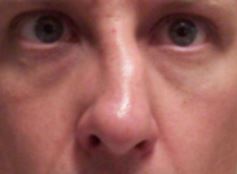
A seroma is a buildup of fluid called serum that collects beneath the skin after surgery. Typically located near the incision site or where tissue was removed, seromas can often be easily managed by your cosmetic surgeon or may resolve on their own; it is one of the most common postoperative complications.
Note, we provide this overview for educational purposes only; immediately contact your surgeon for evaluation if you believe you may have a seroma, as severe or worsening seromas may require treatment.
Identifying a seroma
Most seromas present as a cyst or lump beneath the skin near the incision site that may be sore and sensitive to the touch. If you suspect you may have a seroma, gently tap one side of the area and watch to see if there is a wave-like motion beneath the skin that would indicate fluid collection.
Other seroma indications include a clear or yellowish discharge from the incision. However, fluid that is thick, changes color, or has an odor may indicate an infection; other signs of infection include fever, shortness of breath, and skin that is warm to the touch. Contact your cosmetic surgeon ASAP if you have any of these symptoms.
Though rare, a seroma can calcify and create a hard lump under the skin.
Surgeon tip: If you suspect you may have a seroma, gently tap one side of the area and watch to see if there is a wave-like motion beneath the skin that would indicate fluid collection.
Causes of seroma
The exact causes of seroma formation are not fully understood, but most agree there are a few factors that influence their development. Surgical procedures that disrupt or remove larger areas of soft tissue (i.e. body lifting procedures), typically have higher rates of seroma development. This is because there is a higher likelihood of blood and lymphatic vessels being cut and the “dead space” thus created is subject to increased inflammation and fluid collection during healing.
Engaging in too much physical activity early in the recovery process (or ignoring other post-operative instructions) may also contribute to the development of a seroma. For this reason, board-certified cosmetic surgeons give their patients personalized advice on how to support ideal healing after surgery.
Depending on the procedure, your surgeon may also recommend the placement of surgical drains and/or use specialized surgical techniques to help prevent postoperative seromas.
The most common cosmetic procedures that result in seroma development include:
Treating seromas
Very small seromas that don’t interfere with wound healing may not require medical treatment; the body can safely absorb the fluid as you recover from surgery.
If you have postoperative drains, be sure you aren’t obstructing the tubes to allow proper drainage, and wear your compression garments at all times to help speed healing, until your surgeon advises you otherwise. Your surgeon may also suggest OTC pain medication to help with swelling and discomfort and a warm compress to encourage drainage.
Your surgeon may drain a seroma through needle aspiration in these cases:
- The seroma is excessively large.
- The seroma limits your movement.
- The seroma strains the sutures and could affect your results.
- You have an infection.
Some seromas may refill after aspiration, and your surgeon may advise removing the seroma through a minor surgical procedure to reduce the risk of infection caused by multiple needle aspirations.
Risk of infection
Seromas that don’t resolve on their own or through aspiration may become infected and develop into an abscess—though this is uncommon. Contact your surgeon immediately if you experience any of the following symptoms:
- Fever
- Disorientation
- Rapid heart rate
- Blood pressure changes
- White or bloody discharge
- An opening forming in the suture line
- Increased redness, pain, or swelling around the seroma
How will my cosmetic surgeon prevent complications?
A highly-qualified surgeon will take steps to avoid complications, including only operating in an accredited surgical facility, scheduling follow-up appointments to monitor your progress, and identifying and treating any complication that may occur.
No matter how experienced a surgeon is, there is always some level of risk with each procedure. However, choosing an experienced, board-certified cosmetic surgeon will help to ensure you are given optimal care before, during, and after your procedure. Ultimately, your safety and results will be determined by both the surgeon you choose for your procedure and your commitment to following all pre- and post-surgery guidelines.
Choose a board-certified cosmetic surgeon
Surgeons certified by the American Board of Cosmetic Surgery (ABCS) must demonstrate the highest standards of training and expertise in their specialty and adhere to safe, ethical practices. ABCS surgeons must meet strict qualifications and are re-evaluated every 10 years to retain their certification.
To find an ABCS surgeon near you, use our online directory »



